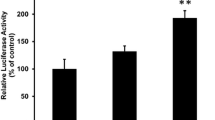Abstract
BM 17.0744, a new anti-diabetic and lipid-lowering agent, leads also to strong hepatomegaly and carnitine acetyl transferase (CAT) increase in the liver of rats, a phenomenon known from fibrates. For information on the relevance of changes in liver of rats to other species, we investigated the effects of BM 17.0744 on lipids and selected marker enzymes related to β-oxidation in rats, dogs and guinea-pigs, so-called high and low responders to peroxisome proliferators. To examine selectivity other enzymes were also determined, e.g. esterase, urate oxidase (UOX) and cytochrome c oxidase (CYT.C.OX.). Lowering of triglycerides and cholesterol in blood serum and/or liver was observed in pharmacological dose range in the three species tested. In dogs and guinea-pigs, liver and kidney weights were unaffected even in dogs in medium and high dose groups with high systemic exposure and severe toxicity. In male Sprague-Dawley rats treatment with 1.5, 3, 6 and 12.5 mg/kg per day BM 17.0744 selectively elevated the activities of CAT and acyl-CoA oxidase (AOX) by ≤200 and 20-fold, respectively. Administration of BM 17.0744 to Beagle dogs (1.5, 4, 12 mg/kg per day) and guinea-pigs (3 and 12 mg/kg per day) enhanced the activities of CAT and AOX dose-dependently by a factor of two to three only. Immunoblotting revealed a drug-specific enhancement of the amount of β-oxidation enzymes in rats, which is in accord with the rapid and coordinated transcriptional activation shown in Northern dot blot analysis. Nuclear run-on assays demostrated a real transcriptional activation. BM 17.0744 activates peroxisome proliferator-activated receptor α (PPARα), which could be shown by transactivation assays. The stimulation of PPARα by BM 17.0744 was stronger than that of the known ligands WY 14.643 and ETYA. Activation of PPARγ can be excluded. Taken collectively, the data demonstrate an enhancement of the β-oxidation system by BM 17.0744 paralleled by lipid-lowering in all species investigated. The activation of the nuclear factor PPARα may explain the changes in liver and the metabolic effects on the molecular level. The lack of an increase in liver and kidney weights and the relatively moderate enhancement of activities of β-oxidation-related enzymes in dogs and guinea-pigs indicate that the excessive response observed in rats is not applicable to other, predominantly non-rodent, species. On the basis of these data and the experience with fibrates a specific risk for humans is not expected.
Similar content being viewed by others
Author information
Authors and Affiliations
Additional information
Received: 27 July 1999 / Accepted: 24 August 1999
Rights and permissions
About this article
Cite this article
Meyer, K., Völkl, A., Endele, R. et al. Species differences in induction of hepatic enzymes by BM 17.0744, an activator of peroxisome proliferator-activated receptor alpha (PPARα). Arch Toxicol 73, 440–450 (1999). https://doi.org/10.1007/s002040050633
Issue Date:
DOI: https://doi.org/10.1007/s002040050633




